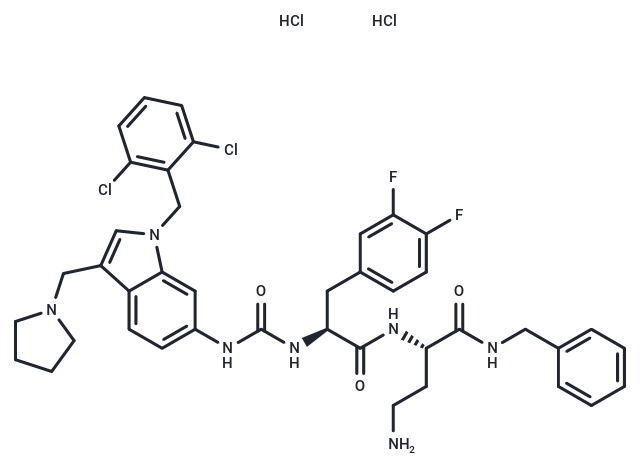Shopping Cart
- Remove All
 Your shopping cart is currently empty
Your shopping cart is currently empty

RWJ-56110 dihydrochloride is a potent, selective, peptide-mimetic inhibitor of PAR-1 activation and internalization (binding IC50=0.44 μM), showing no effect on PAR-2, PAR-3, or PAR-4. It inhibits the aggregation of human platelets induced by SFLLRN-NH2 (IC50=0.16 μM) and thrombin (IC50=0.34 μM), with high selectivity relative to U46619. RWJ-56110 dihydrochloride also blocks angiogenesis and the formation of new vessels in vivo, and induces cell apoptosis[1][2].

| Pack Size | Price | Availability | Quantity |
|---|---|---|---|
| 5 mg | $481 | Backorder | |
| 10 mg | $813 | Backorder | |
| 25 mg | $1,570 | Backorder | |
| 50 mg | $2,650 | Backorder | |
| 100 mg | $4,150 | Backorder |
| Description | RWJ-56110 dihydrochloride is a potent, selective, peptide-mimetic inhibitor of PAR-1 activation and internalization (binding IC50=0.44 μM), showing no effect on PAR-2, PAR-3, or PAR-4. It inhibits the aggregation of human platelets induced by SFLLRN-NH2 (IC50=0.16 μM) and thrombin (IC50=0.34 μM), with high selectivity relative to U46619. RWJ-56110 dihydrochloride also blocks angiogenesis and the formation of new vessels in vivo, and induces cell apoptosis[1][2]. |
| Targets&IC50 | PAR1:0.44 uM (IC50), Platelet aggregation (human, SFLLRN-NH2-induced):0.16 μM (IC50), Platelet aggregation (human, thrombin-induced):0.34 μM (IC50) |
| In vitro | Proteinase-activated receptors (PARs) are a family of G protein-coupled receptors activated by the proteolytic cleavage of their N-terminal extracellular domain, exposing a new amino-terminal sequence that functions as a tethered ligand to activate the receptors. RWJ56110 inhibits the aggregation of human platelets induced by SFLLRN-NH2 (IC50=0.16 μM) and thrombin (IC50=0.34 μM), while being selective relative to collagen and the thromboxane mimetic U46619 [1]. RWJ-56110 dihydrochloride fully inhibits thrombin-induced RASMC proliferation (IC50=3.5 μM) and blocks thrombin's action on RASMC (IC50=0.12 μM), HMVEC (IC50=0.13 μM), and HASMC calcium mobilization (IC50=0.17 μM) [1]. RWJ56110 (0.1-10 μM; 24-96 hours) inhibits endothelial cell growth dose-dependently, with a half-maximal inhibitory concentration of approximately 10 μM [2]. RWJ56110 (0.1-10 μM; 6 hours) inhibits DNA synthesis of endothelial cells in thymidine incorporation assays, primarily in fast-growing cells (50-60% confluence), while its effect is less pronounced in quiescent cells (100% confluent) [2]. RWJ56110 (0.1-10 μM; pretreatment for 15 min) inhibits thrombin-induced Erk1/2 activation concentration-dependently, and partially reduces Erk1/2 activation levels when endothelial cells are stimulated by FBS (final concentration 4%) [2]. RWJ56110 (30 μM; 24 hours) inhibits endothelial cell cycle progression, reducing the percentage of cells in S phase, with less pronounced alterations in G1 and G2/M phases [2]. Western Blot Analysis [2] Cell Line: Endothelial cells. |
| Molecular Weight | 827.2 |
| Formula | C41H44Cl3F2N7O3 |
| Cas No. | 2387505-58-8 |
| Storage | Powder: -20°C for 3 years | In solvent: -80°C for 1 year | Shipping with blue ice. |

Copyright © 2015-2025 TargetMol Chemicals Inc. All Rights Reserved.